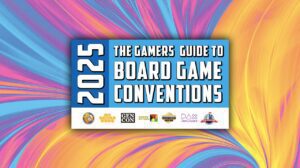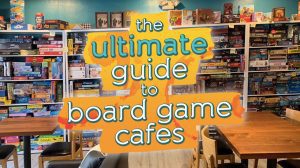Disclosure: Meeple Mountain received a free copy of this product in exchange for an honest, unbiased review. This review is not intended to be an endorsement.
Confession time: I don’t really like co-op games.
It’s not that I don’t “work well with others” but there’s something about collaborating as a team, assigning specific tasks to each person towards accomplishing a shared goal that just feels like, well, a job. And that’s not the reason I play board games. I have a job already and this is supposed to be a hobby. Usually when I play cooperative games, I just wind up making my fellow players mad because while they’re all working together to take down a baddie, I’m usually off in another room looting a chest for myself. I can’t help myself. It’s in my nature. I enjoy competition.
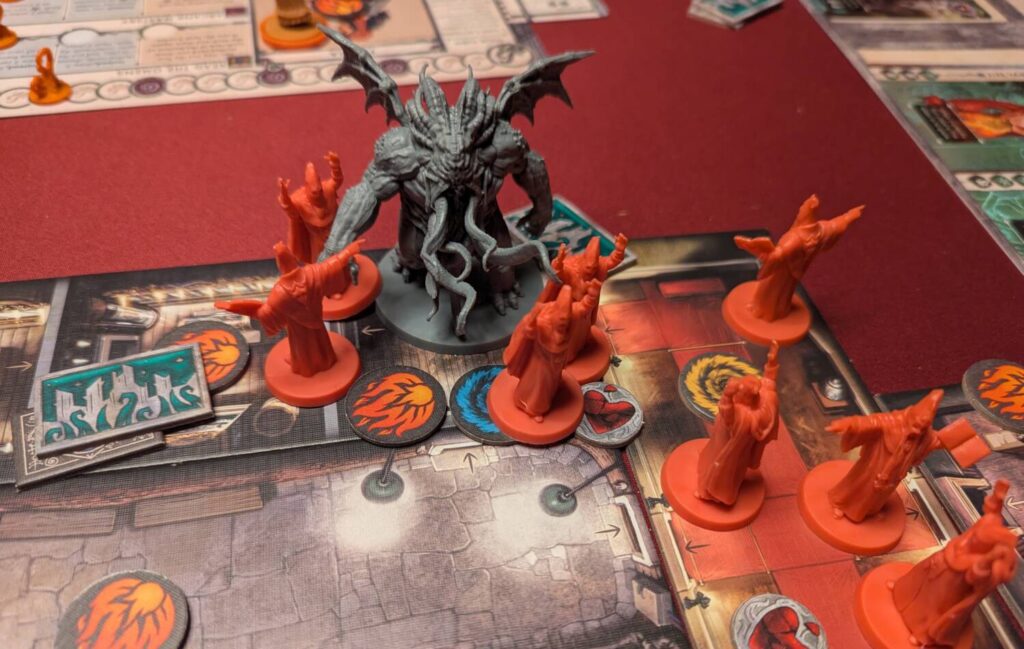
So, given my issues, why did I decide to review the co-op, dungeon-crawling game Cthulhu: Death May Die? The answer is simple: it’s designers Eric M. Lang and Rob Daviau. Among the many titles in their combined resumes, Lang has made some of my favorite area-control games in Blood Rage and Rising Sun, and Daviau created an entirely new genre with the Legacy series, re-imagining classic games like Risk and Pandemic and transforming them into, arguably, superior versions.
Hell Awaits
In Cthulhu: Death May Die, players take on the role of investigators, teaming up to defeat a gigantic and powerful “Elder One”–in the base game, either Hastur or the titular Cthulhu. Before you are able to do any damage to the Elder One, however, you’ll need to first disrupt a ritual, specific to the story in each of the 6 included episodes (which can be played in any order) and this is where teamwork becomes so vital.
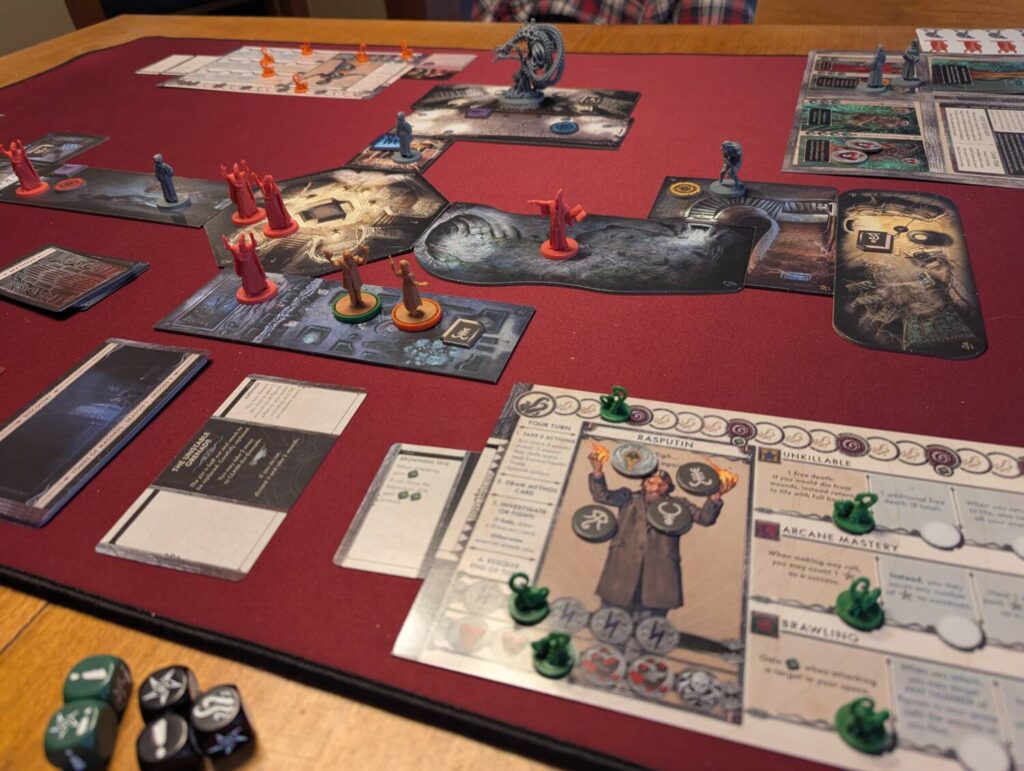
Each episode works in a similar fashion. It presents a scenario where some special tasks must be completed, spread out around the map, to disrupt the ritual. Along the way, there are monsters and cultists, large and small, to deal with. You roll some dice, assign hits and misses, and then draw a Mythos card, which is always something bad (for example, a new enemy spawning on the map or one moving closer to your current position) and, if you’ve done well on your turn, you may get a reward in the form of a Discovery card – a tool or companion to help boost your chances of survival.
Insane in the Membrane
Based on gameplay rules, it all seems pretty standard for co-op dungeon-crawling fare, but what really sets Cthulhu apart is the insanity. You see, among the hits and misses on the dice, there are tentacles, which raises your investigator up on your Sanity Track. At certain points on this track, you will hit an insanity threshold, triggering your personal affliction (dealt out before the game) but it will also allow you to level up on one of your four skill tracks. This is really the beating heart (or pulsating brain) of the game.

Taking insanity and upgrading your skills unlocks some game-changing abilities, such as attacking from several rooms away, attacking multiple enemies at once, free re-rolls, and gaining extra dice for the rest of the game. Early on, you’ll take every tentacle you can get. Pushing it to the end of that track, though, means death and those final insanity thresholds are right near that skull symbol at the end, meaning you won’t be at your full destructive power until you’re nearly dead. It’s that balancing act where the game delivers the most chaotic fun I’ve had in a long while.
Get the Balance Right
Cthulhu: Death May Die is great at all player counts. I was surprised, at first, given that there are no separate setup or game rules for different player counts. I figured, like in most games, there would be fewer tasks to resolve for disrupting a ritual or enemies starting on the board at two players, but not so. Because those Mythos Cards determine when enemies are added or move, it actually scales the difficulty to every player count based on each investigator simply taking their turn, without the need to adjust any rules. It’s a pretty brilliant stroke of design, actually.
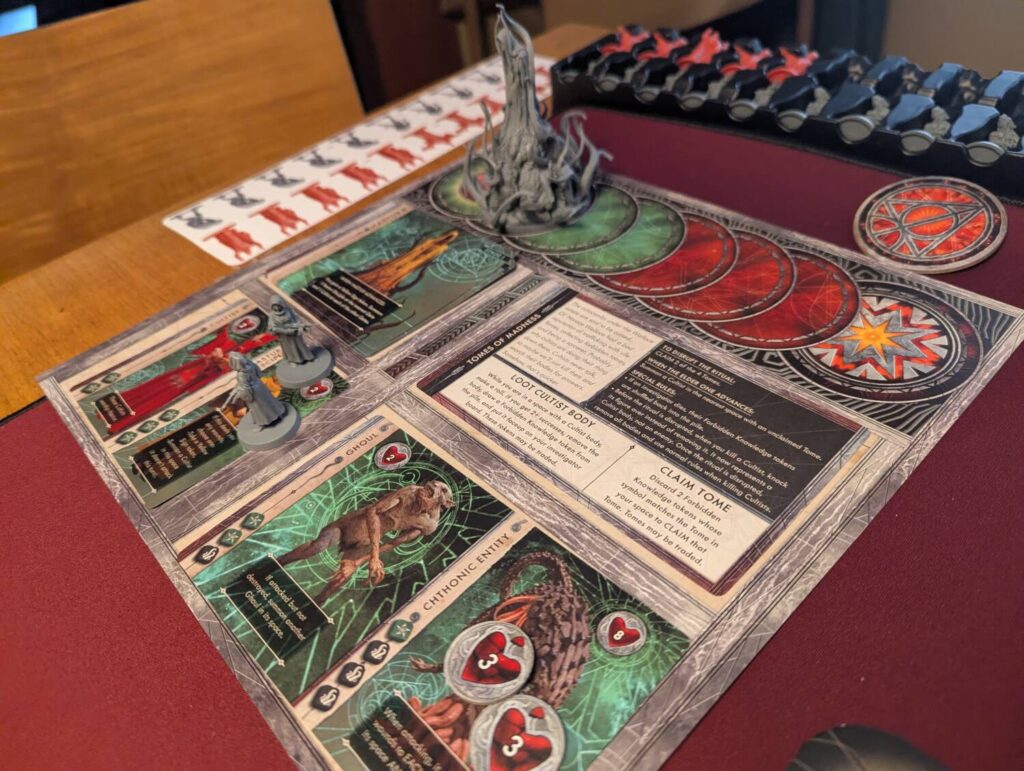
Additionally, the Elder One starts off the board and has his own track, and creeps closer to joining the party based on symbols on the Mythos Cards. This means that in a 2-player game you are given a bit more time to get to all the places spread out across the map that you need to disrupt the ritual before the Elder One comes onto the map. Having 5 players will help you get to those locations quicker, but it also means the map will be filled with even more enemies quicker as well, and it increases the chances of The Elder One showing up before you’re ready for them. Achieving this kind of player count balance without any variation in setup means less time in the rulebook and more time in the game.
I Get by With a Little Help from My Friends
So, there I was–the guy who doesn’t like working as a team and will almost always choose the actions that benefit myself–consulting with my fellow players to formulate the best plan and strategy for my own upcoming turn. What have I become? In Cthulhu: Death May Die, I discovered the real joy in collaboration in a board game. Is this what other fans of co-op games have been raving about?
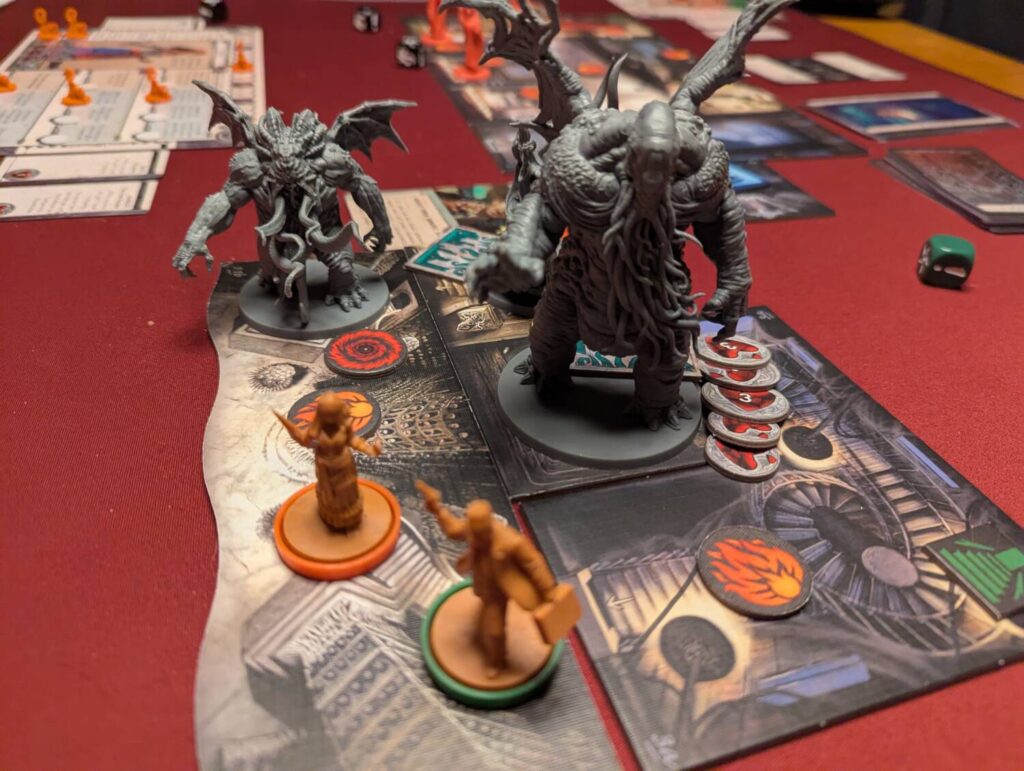
By making every turn an opportunity to push my skill tree up, the game was incentivizing me with individual rewards for maximizing my own actions that benefit the entire team. There’s also a rule that if one investigator dies before the ritual is disrupted, the game ends immediately, so spoiling everyone’s experience for selfish reasons was motivation enough to avoid going my own path in every scenario. Once that goal has been accomplished, you can (and likely will) lose one or more investigators before the chapter concludes, but without sacrificing the team. Now that the Elder One is vulnerable, I was gladly willing to go out in a blaze of glory for the whole squad.

Getting Mighty Crowded
Unsurprisingly, coming from a publisher called Cool Mini or Not, all the cultist and monster figures are incredibly designed. It’s always fun to bring a new one onto the board and spend a few moments to check out all the little, grotesque details. Those who enjoy painting minis will have a blast with this game. Several are also very large, however, and this can lead to one of the few issues I ran into during my playthroughs–many of the rooms are just too darn small.
It can already be difficult–because of the grey, blue, and black palette of the board–to determine where one room begins and another one ends. When a small room with space for about 3 standard figures is suddenly filled with 8-10 investigators, monsters, and an Elder One, it becomes even more problematic trying to keep track of which are actually involved, especially if the room next to it is also filled to capacity. Larger and more clearly defined game board pieces for each room would help alleviate this.
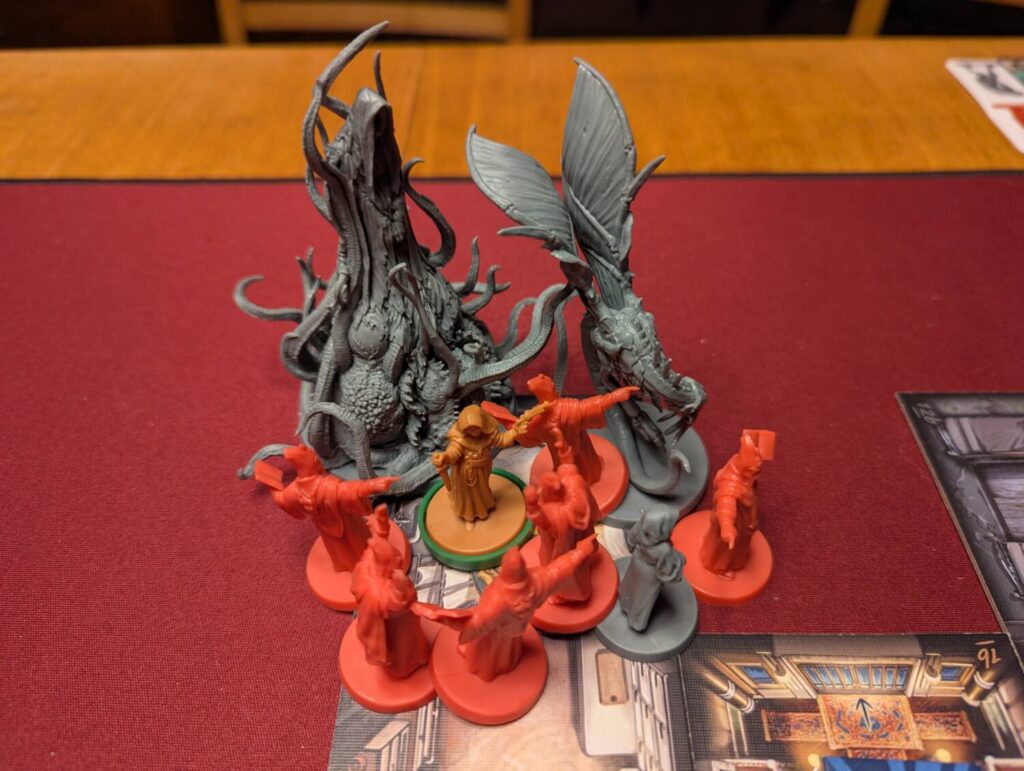
Speaking of the Elder One’s, as wonderfully rendered and truly daunting as they appear visually, only two are included in the game, which limits their difficulty ceiling after multiple plays. Each Elder One has 3 stages before it is eliminated, becoming more powerful in each subsequent stage. Once you have defeated a stage, it will move, and reveal one immediate effect and one ongoing effect, which are added to all previous stages’ effects.
The first time that you play, these stacked effects can become completely devastating and overwhelming, but also wildly fun, forcing you in some tough spots and decision-making, like any good boss battle does. In future playthroughs, since you only have two Elder One’s to choose from, the team knows exactly what’s coming and can prepare for the upcoming effects. I found it takes a bit of enjoyment out of that element of the game. I really would have liked some variation in the Elder Ones’ stage effects, which could have been achieved with just a few extra cards.
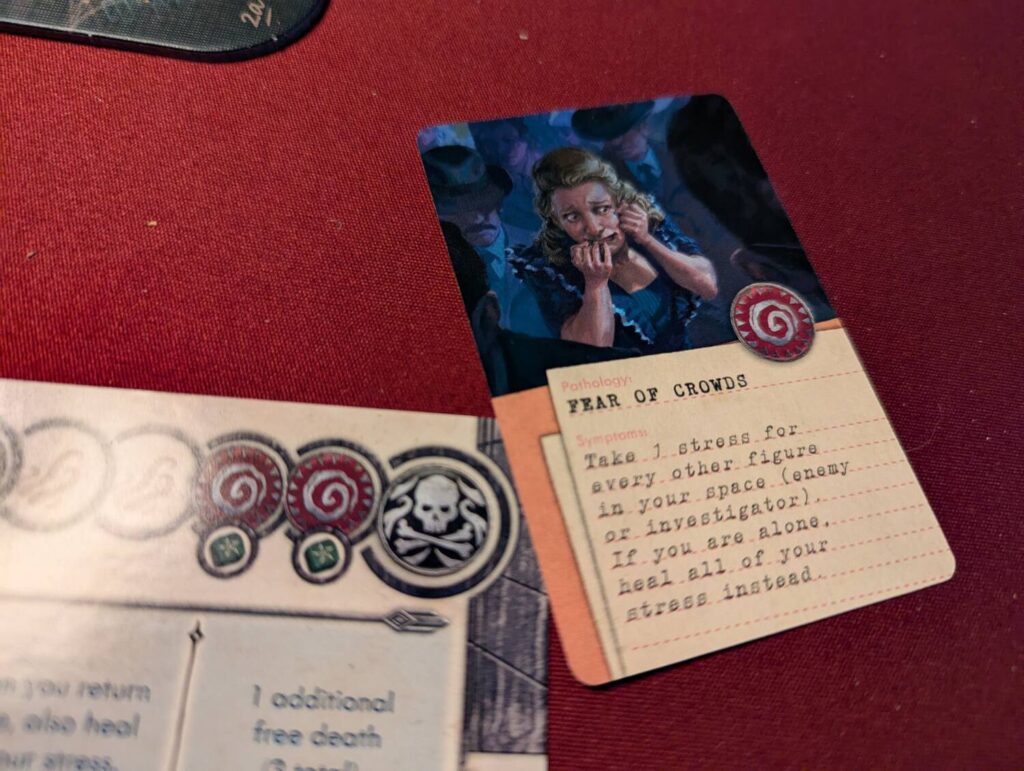
Let’s Go Crazy, Let’s Get Nuts
These issues with Cthulhu: Death May Die are mostly cosmetic, or simply complaints about not getting more of what is already great out of the box. As of this writing, there are several expansions and individual Elder One’s for purchase that help alleviate most of these concerns. I can tell you now, I am looking forward to trying every one of them. Simply put, this game delivered some of the best times I’ve had playing with a group of friends in a very long time and I can’t wait to get back in the fight and go a little (or, better yet, a lot) insane.
Have I “seen the light” in the world of co-op dungeon crawlers? Have I become the ultimate team player? Based on other, similar games that I’ve played, not likely. I’m still more inclined to abandon a teammate than have their back, if the rewards benefit me personally. Maybe if all games in the genre were as good as this one, however, this zebra would think about changing his stripes permanently.
I’m not reformed, but Cthulhu: Death May Die has me on the road to recovery.










